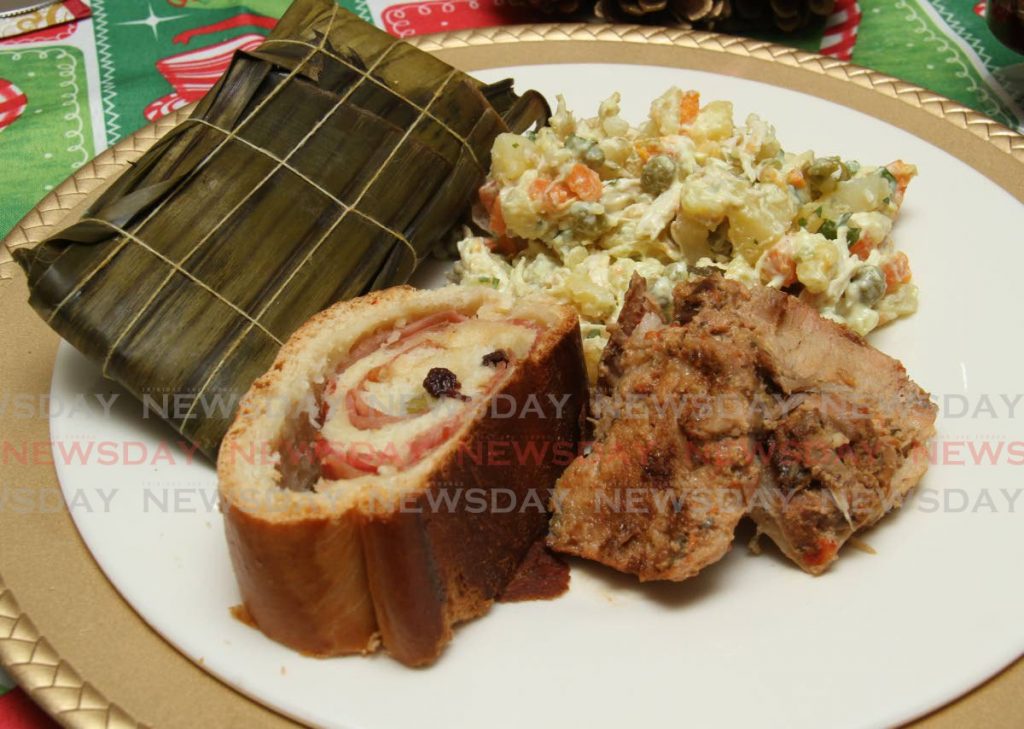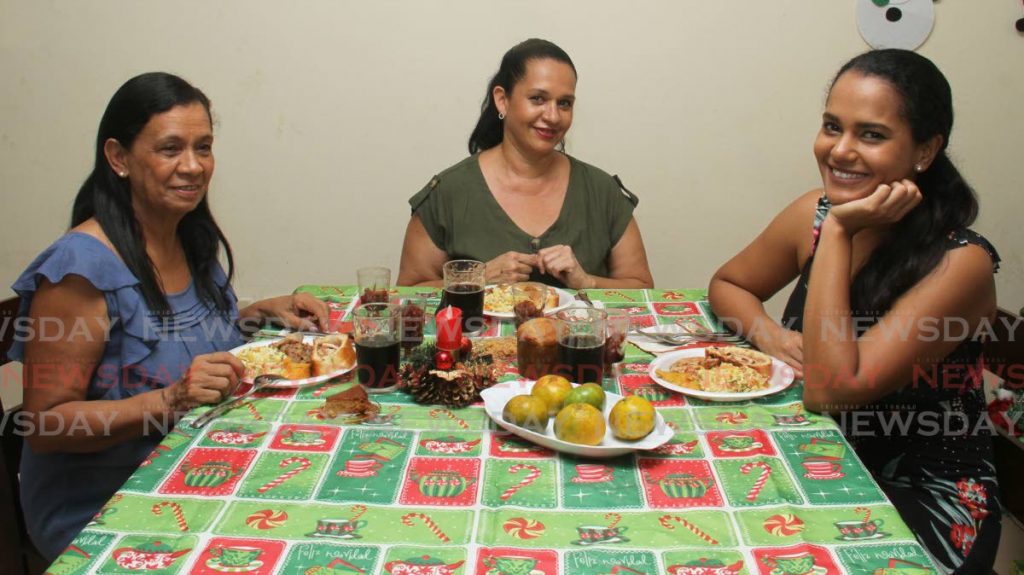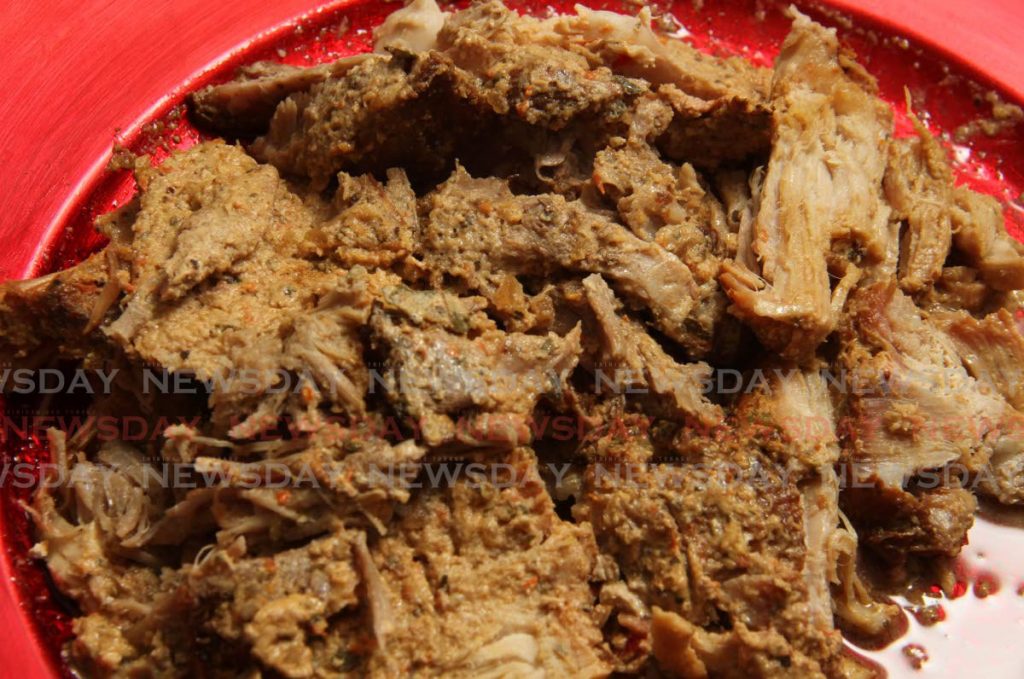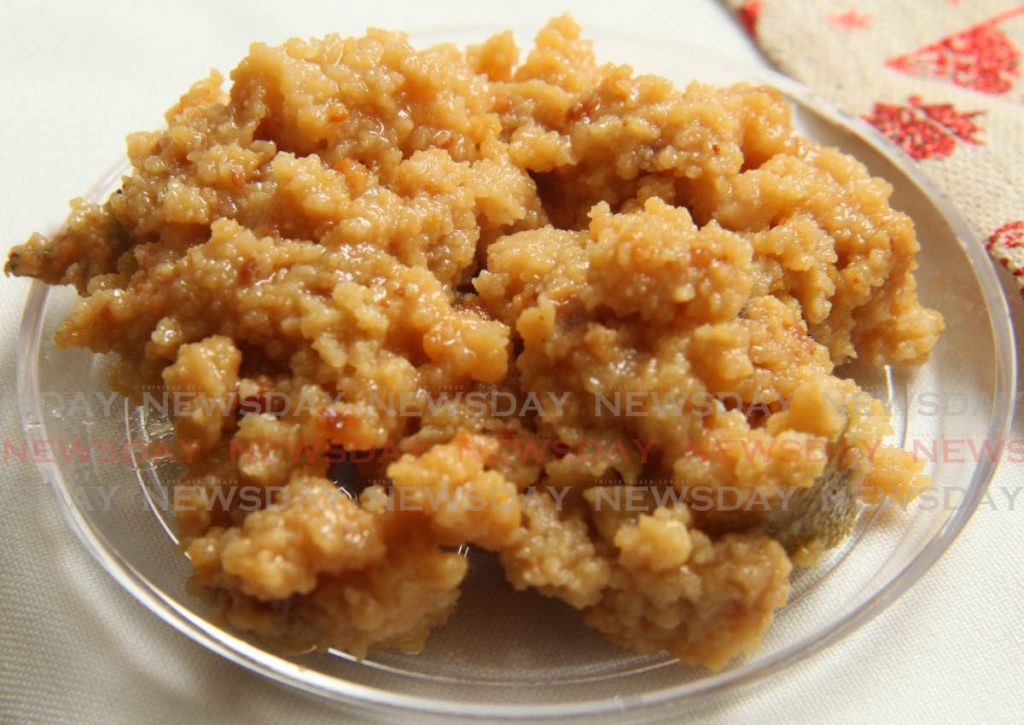Venezuelan Christmas with flavour and joy

The crisis in Venezuela has forced Venezuelans to seek opportunities in other countries, including TT. And, like all other immigrants, they’ve brought their traditions with them so they can feel at home. Ivonne Gascón is no different.
Gascón, who had lived her entire life in the South American country, came to TT a year and six months ago with her skills and recipes in tow. And with the arrival of the Yuletide season, Gascón spoke with Newsday about the traditions of a Venezuelan Christmas meal.
She said the hallaca, ham bread, chicken salad and pork leg combine their flavours to give Venezuela the most beautiful season of the year – a meal she is now sharing with TT.
The hallaca is the great protagonist of the Christmas table and has its origin at the time of the colony. It is a corn tamale with a chicken, meat or pork stew, to which other ingredients are added (it depends on the region where it is made), it is wrapped in plantain leaves and then cooked.
“It is probably the most elaborate dish of Venezuelan cuisine and is only eaten during the last two months of each year, especially in December. The family gets together and everyone contributes to make them come out perfect,” explained Gascón. They combine it with fruits such as grapes, tangerines, nuts, paneton and black cake.
The hallaca is the main element of this dish because it identifies and marks the flavour of the season and unifies the entire dish. It is served at Christmas from one family to the other, like a great gesture of affection.

Gascón has 25 years working with Venezuelan Creole food, especially around Christmas time.
“In Venezuela I worked for orders. I had contacts with many companies for the preparation of food for their workers’ end-of-the-year parties. I came to TT with the idea of being able to do the same, and I am doing it. Traditional Venezuelan Christmas food is starting to reach Trinidadian homes too,” she said.
She hopes that, like in Venezuela, the tradition of sharing this special meal can be adopted in TT.
“In September we started selling the Christmas dish on request, for now only Venezuelans make orders, but I’m sure that the locals will try it too.”
She prepares a combo: hallaca, ham bread, salad and pernil accompanied by a papaw candy. She also sells empanadas by orders on Saturdays, with delivery.
“We are doing about 35 dishes on weekends.”
She said there are organisations and expert chefs teaching Trinidadians how to prepare these meals. The Hispanic Cultural Centre in Arima, for example, offers a course on Wednesdays and Fridays at 6 pm.
Additionally, she prepares local lunches for a convent in Arouca. She said she learned to prepare these with the help of neighbours and the internet.
Gascón recognises that Venezuelan and Trinidadian cuisine have many similarities and it is easy to get some of the ingredients here. Cornmeal, meat, vegetables and dressings, colouring and powders can be purchased at supermarkets.
But not all of them. She said the plantain leaf in which the hallaca is cooked and the thread with which they are tied, is difficult to find.
“The leaves are commissioned with friends who have sowings, they sell us the leaves, but we then have to prepare it by burning them and cutting to measures to be able to mount the hallaca.”
Similarly, with pork legs.
“In Venezuela we prepare the whole leg, the whole leg. But not here. They sell it in slices.”
For more information follow Gascón on Instagram @ivonne_itg.
Hallacas
Yield: 35 portions
Ingredients
1 kg fat-free pork chopped into small pieces
2 kg beef cleaned and cut into small pieces
2 kgs chicken previously cooked together with ½ kg whole bacon
½ kg of onion cut into small dice
½ kg leeks cut into thin casters
¼ kg finely sliced scallions
¾ kg garlic peeled and crushed
½ cup capers or to taste
½ cup seedless olive
½ cup raisins
½ red sweet pepper without seeds
½ seedless red paprika
2 cups of red wine
Oil with annatto
Salt and pepper
Cornmeal dough
Plantain leaves and thread
Directions
Guiso (Stew)
In a large pot or dutch oven, saute bacon until fat is rendered. Add pork and beef along with cumin, paprika, turmeric, and cayenne pepper. Season with salt and pepper then cook over high heat for 5 minutes. Add onions, tomatoes, garlic, leek, celery, and bell pepper. Cover and bring to a boil. Lower heat and continue cooking until all meat is tender, about 1 1/2 hours.
Once meat is tender, add lemon juice and sugar. Stir and taste to adjust seasoning. Set aside until guiso has cooled completely. This may be done ahead and refrigerated.
Masa (Dough)
Over a low heat, cook oil with annatto seeds in small sauce pan. Simmer for about 5 minutes. Cool down to room temperature, strain and discard seeds.
In a large bowl (or food processor) mix in masa harina, salt, water, and annatto oil. Form dough into 24 balls.
To assemble
Lightly oil the centre of a banana leaf square. Put a ball of masa in the centre of each square and flatten dough out to 1/8-inch thickness. Top each masa-coated banana leaf with meat mixture and top/garnish with a strip of pepper, onion ring, a slice of hard boiled egg, a few raisins and capers, and two olives.
Fold leaf to completely encase the filling, making rectangular pockets. Hallacas can be roughly 6 inches x 3 inches. Tie each hallaca with kitchen twine. Steam in large pot, covered, for 1 hour.
Serve hot.
Hallacas can be refrigerated (or frozen) and steamed to reheat before serving.
Ham Bread

Yield: 1 loaf, enough for 4 to 6 people
Ingredients
3/4 cup warm milk
4 tbsp butter
2 tbsp sugar
1 tsp salt
1/4-ounce package dry active yeast
1/4 cup lukewarm water
3 1/2 cups all-purpose flour
1 egg, beaten
2 tbsp melted butter
1/2 lb thinly sliced ham
1/2 cup raisins
1/2 cup pimento-stuffed olives
2 egg yolks
Directions
Place the warm water in the bowl of a stand mixer. Sprinkle the yeast over the water and let stand for 5 minutes. Add 1 cup of the flour, the butter, and egg, and mix well using the dough hook attachment. Add the softened butter and another cup of flour and mix well.
Add the remaining ingredients and knead until smooth, adding a bit of extra flour if the dough is too sticky. When well kneaded, the dough should be soft, shiny, and smooth.
Place the dough in an oiled bowl. Cover with plastic wrap, set in a warm location, and let rise until doubled in bulk, about 30 minutes.
Divide the dough in half. On a lightly floured surface, roll half of the dough into a large rectangle about 10 x 12 inches.
Brush the dough with 1 tablespoon of the melted butter. Place half of the ham slices over the dough, leaving a 1-inch border all around.
Sprinkle half of the raisins and half of the olives around over the ham.
Tightly roll up the dough lengthwise starting with the long edge, sealing the last part of the dough to the roll with some water.
Place roll, seam side down, on a parchment-lined baking sheet, and tuck the ends under slightly. Repeat with the other half of dough.
Mix the egg yolk with a teaspoon of sugar and brush the mixture onto the rolls with a pastry brush.
Lightly cover the rolls with oiled plastic wrap and let rise in a warm place for about an hour.
Bake bread at 350 F for 30 to 40 minutes, until golden brown.
Remove from oven, and let it cool slightly before slicing.
Pernil

Yield: 10 servings
Ingredients
1 6-kg pork shoulder or loin with or without the bone
2 large white onions
17 garlic cloves
1/2 cup vegetable oil
2 tbsp Worcester sauce
1/4 cup wine vinegar
1 tbsp dried oregano
1 tbsp dried rosemary
2 or 3 thyme sprigs
2 bay leaves
2 cups of orange juice
Salt and black pepper to season
Few sprigs of fresh rosemary
For the sauce:
1/2 cup Moscatel or Madeira wine
1/4 tsp black pepper
1 tsp Worcester sauce
1 tsp flour optional
Directions
In a food processor, blend the onions, garlic, salt, black pepper, thyme leaves, vinegar, orange juice and Worcester sauce until you get a smooth paste (the important thing is to have all the ingredients mixed together).
Add the marinade to the pork and massage it into the meat. Cover and leave in the fridge until next day.
Remove the pork from the fridge one hour before roasting, cover with aluminium foil and place it in a preheated oven at 200 degrees C/400 F for approx 40 minutes per kg.
Once cooked, remove the aluminium foil, increase the temperature to 220 degree C/450 F and leave to roast until golden brown, approx 10/15 per kg basting every so often.
Once the pork is cooked and golden brown, remove from the oven and wrap it in aluminium foil to rest for at least 20 minutes.
In the meantime place the roasting tray on the stove and add the wine, black pepper, 1 tsp of Worcester sauce and the flour if using. Mix everything with a whisk to dissolve the flour.
Leave to boil for approx 10 minutes.
Pass the gravy through a sieve or fine colander to remove all large bits and finish with a smooth gravy.
Remove the pork from the foil, carve in thin slices and drizzle some of the gravy on top.
Serve immediately.
Recipe Notes:
If you like a thinner, softer and lighter gravy add water to taste, balancing the flavour with more or less Moscatel wine.
For cooking smaller joints always divide the recipe in half or quarter, in this case a 3kg or 1.5kg joint and modify the ingredients accordingly.
Pawpaw Sweet
Yield: 7 servings
Ingredients
2 kilos of green pawpaw
2 kilos of papelón (unrefined cane sugar)
1/2 kilo of sugar
1 tsp baking soda
1 clove
Jamaican pepper
Water
Directions
Peel the pawpaw and cut into slices. Rinse and place in a bowl with 3 cups of water and add baking soda. Let it rest overnight. The next day put in a colander and rinse the pawpaw.
Place papelón a container with ½ cup of water overnight to soften.
Add in a large pot, 6 cups of water, papelón, the cinnamon, cloves and Jamaican pepper and bring to a boil. Then add green pawpaw slices, white sugar and pinch of salt. Cook to low heat until de papaya is tender and the syrup is reduced.
Remove from the stove and let it cool down. Place in a glass container or individual containers and keep in the refrigerator until being served.
Recipe Note:
In other countries these are the names of papelón: panela (Colombia), piloncillo (Mexico), rapadura (Brazil), jaggery (India).
Curdled Milk Fudge

Ingredients
Fresh or curdled milk
3/4 cup of sugar
1 egg at room temperature
2 1/2 cups of whole milk at room temperature
1 large cinnamon stick
1 teaspoon of grated lime peels
1 teaspoon of grated orange peels
1/4 cups of raisins or prunes
1/4 cup of lime juice at room temperature
Directions
To curdle milk quickly, add white vinegar or lemon juice to the milk. For 2 litres, you’ll use two tablespoons. For a gallon, you will use 3-4 tablespoons of white vinegar or lemon juice. Let it sit for about 10-15 minutes, without stirring it and you’ll soon see it splits.
Add your curdled milk, sugar, lime peels, and cinnamon sticks to a caldero or a wide deep pot. Mix it together and cook it over medium low heat.
For every litre of milk you’re using for your dulce de leche cortada, you will add about a cup worth of white granulated sugar. Remember, the sugar is what makes the caramel candy at the end.
Pay attention to the liquid level of the pan as the cooking progresses.
As the cooking begins, you’ll see more curdling happening.
After about an hour, your dulce de leche cortada should be forming. Compare the liquid level from the beginning. At this point you can occasionally begin to stir the pot, just to keep the dulce from burning at the bottom.
Continue cooking until most of your liquid has evaporated or the milk is more fudge-like. You want your dulce de leche cortada to be like a ragu or picadillo consistency: a little wet, but not soup-like.
Transfer the curdled milk candy into a large bowl. You can serve this hot or cold.
Refrigerate any leftovers.


Comments
"Venezuelan Christmas with flavour and joy"